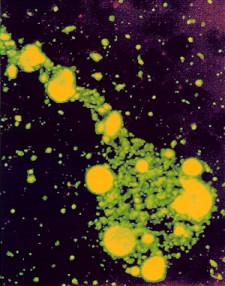| Causes/ Source |
|
This disease is an animal disease. Rabies can only be transmitted by a bite of a sick warm-blooded mammal. It can not be transferred to another human by a human so human is a dead end. However, rabies can be transmitted by infected meat as Darwin observed among Peruvians who ate beef from a rabid bull. However, rabbits and rodents such as squirrels, are almost never infected.
Wild Animals such as raccoons, skunks, bats, foxes, etc., still remain the virus's main reservoir. Of the 8,644 animals reported with rabies in 1992, 43% of them were raccoons and 7% were bats. As such, it is highly unlikely that this disease will ever be eliminated.
It is "neurotropic" meaning it loves nerve cells. It drives its victims crazy so it can jump to the next host. It is transferred via saliva that enters broken skin. Salivary glands actually become infected before there is any overt signs of rabies.
The virus might also be airborne, though it's uncertain. A few bat cave explorers have been infected.

|
Picture from Wadsworth Center, New York State Dept. of Health |
| .. Next page |